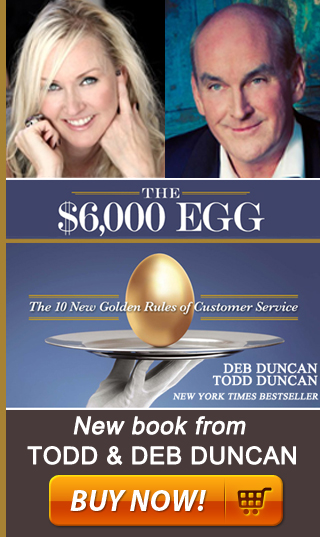Killing The Sale: Are You Ignoring Change? |
Jul.30 |

By Todd Duncan
In the world of sales, simply meeting customers’ expectations is good enough to secure a client, but not necessarily to keep a client. In an era of ever-expanding choices, being successful in the sales profession takes more than courtesy and kindness. It takes more than mere professionalism. And it takes more than merely meeting customers’ needs. Yet many salespeople are still selling with a simple arsenal of service, value, and good products. And while those things are integral parts of being a successful salesperson (in other words, you can’t be successful without them), they are not enough to set you apart from your competition in the long run.
In short, service, value, and good products can earn you the trust of your clients, but these things will not necessarily keep your clients loyal in the long run because smart consumers always have wandering eyes, searching for better deals. Other salespeople who are striving to improve their game are also taking steps to increase their level of service, add more value, and improve their products.
A Selling Cesspool
Many salespeople never learn that what got a client to buy yesterday will not necessarily win a client today. And as a result, many salespeople end up lagging behind in new sales or losing longtime clients to the cutting-edge competition. But it’s the inevitable result of our final fatal mistake called “stagnating.”
Salespeople who make the mistake of stagnating are out of touch with their clients and their sales climate. But unlike our previous mistake of skimming, stagnating is not really a mistake of negligence. It is better classified as a mistake of naiveté. Stagnating is not failing to retain clients because of a lack of investment in the relationships. It’s a failure to gain and retain clients because of a lack of professional growth and discernment.
Stagnating is losing your selling edge through sluggish growth or slow insight. It’s using a static sales strategy in a dynamic industry. It’s assuming the selling climate in your industry hasn’t changed in months and then setting sail on the ever-changing, unforgiving sales seas. And when you make the mistake of stagnating, you usually end up getting blown out of the water by the more savvy and forward-moving competition.
Many things change in the sales industry on a regular basis. And if you don’t adjust your selling strategy along with the changes, if you don’t continue to raise your own selling bar, you will end up stuck in the mud while your competition glides by you.
The Times They Are A-Changin’
Products change, clients’ values and needs change, markets change, and ultimately you change.
Do life changes affect the way you sell? You better believe it. When you’re single, it’s much easier to appeal to younger, single clientele. When you’re married, that may change. Furthermore, when you have children, your set of circumstances and your values are entirely different from your days before children. As a result, not only does your ability to appeal to a different crowd change, the things you sell may not be as appealing to you. And that’s an important point to consider.
If your product has lost its luster with you, how do you expect to sell it to another person? The bottom line is that you are a part of your product. And when you sell, you’re selling not only your product or service but also yourself. Therefore, as you change, so does your sales offering—whether you like it or not.
The Necessity of Change
Stagnating is essentially selling the same way year after year with the naive assumption that nothing has changed. That your product or service hasn’t changed. That the market hasn’t changed. That your clients or potential clients haven’t changed. That consumers’ wants and needs and values haven’t changed. That you haven’t changed. But everything changes, all the time. Therefore, to overcome the fatal mistake of stagnating, so must you.
To avoid the stink of a stagnant sales career, you must learn to grow with change. In other words, you must learn to keep a finger on the pulse of the market (something we hear quite often) and on the pulse of your clients’ needs and values, the pulse of your product or service, and your own pulse. It’s a good thing you have so many fingers.
comments powered by Disqus


 Follow me on Twitter
Follow me on Twitter Like me on Facebook
Like me on Facebook  Connect on LinkedIn
Connect on LinkedIn